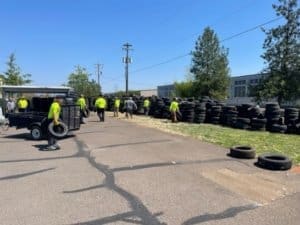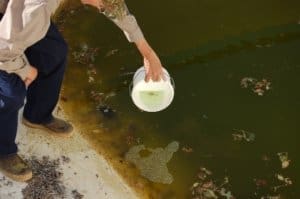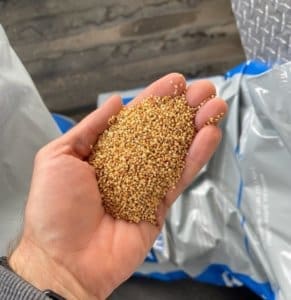Source reduction and managing all mosquito life stages are important elements of integrated mosquito management.
Source Reduction
 Source reduction refers to the direct manipulation of habitats where mosquitoes reproduce. This would include things like ditch cleaning, filling/leveling low areas, clearing debris piles, or grading to improve drainage. Although JCVCD lacks the budget to maintain our own heavy equipment for these purposes, our staff works closely with landowners who are experiencing problems with mosquitoes and advises them on ways they can reduce mosquito sources. Source reduction also includes small-scale improvements like identifying and dumping water-filled containers and unclogging gutters. JCVCD stages an annual free tire drive to help Jackson County residents remove old tires from their properties which can be significant mosquito sources.
Source reduction refers to the direct manipulation of habitats where mosquitoes reproduce. This would include things like ditch cleaning, filling/leveling low areas, clearing debris piles, or grading to improve drainage. Although JCVCD lacks the budget to maintain our own heavy equipment for these purposes, our staff works closely with landowners who are experiencing problems with mosquitoes and advises them on ways they can reduce mosquito sources. Source reduction also includes small-scale improvements like identifying and dumping water-filled containers and unclogging gutters. JCVCD stages an annual free tire drive to help Jackson County residents remove old tires from their properties which can be significant mosquito sources.
Biological Mosquito Control
 Biological control refers to the use of organisms that prey on larval or adult mosquitoes to reduce their populations. JCVCD promotes biological control by first and foremost encouraging natural mosquito predators in habitats where they are already present. JCVCD uses control products that are selective for mosquitoes to minimize impacts to other species. JCVCD augments natural biological control by using mosquitofish (Gambusia affinis). Similar in size and appearance to guppies, mosquitofish are known to actively prey on mosquito larvae and pupae. Because they are non-native, the Oregon Department of Fish and Wildlife (ODFW) stipulates that mosquitofish can only be placed in self-contained bodies of water such as ornamental ponds, fountains, and water troughs.
Biological control refers to the use of organisms that prey on larval or adult mosquitoes to reduce their populations. JCVCD promotes biological control by first and foremost encouraging natural mosquito predators in habitats where they are already present. JCVCD uses control products that are selective for mosquitoes to minimize impacts to other species. JCVCD augments natural biological control by using mosquitofish (Gambusia affinis). Similar in size and appearance to guppies, mosquitofish are known to actively prey on mosquito larvae and pupae. Because they are non-native, the Oregon Department of Fish and Wildlife (ODFW) stipulates that mosquitofish can only be placed in self-contained bodies of water such as ornamental ponds, fountains, and water troughs.
Larval Mosquito Control
 The District’s primary focus is on controlling mosquitoes in the larval stage before they become flying adults. We control mosquito larvae by using products referred to as larvicides. Larvicides can be granular, pelletized, liquid, or packaged in water-soluble pouches. The most common larvicides are classified as either bacterial, spinosyns, or insect growth regulators. Bacterial larvicides use mosquito-specific bacteria, Bacillus thuringiensis (Bti) being most common, that, once ingested, produces proteins that disrupt the midgut of mosquito larvae. Spinosyns use Spinosad, a toxin produced from the fermentation of soil bacteria which interferes with a larva's nerve function. Insect growth regulators, primarily S-Methoprene, release hormones that prevent mosquito larvae from progressing to the adult stage. These products control mosquito larvae well but are not nearly as effective against pupae. When the control of pupae is needed, surface oils can be used which deprive the pupae of oxygen. Modern larvicides are safe for use in water sources as small as a few ounces or as large as several acres and provide extended control of larval mosquitoes with fewer applications.
The District’s primary focus is on controlling mosquitoes in the larval stage before they become flying adults. We control mosquito larvae by using products referred to as larvicides. Larvicides can be granular, pelletized, liquid, or packaged in water-soluble pouches. The most common larvicides are classified as either bacterial, spinosyns, or insect growth regulators. Bacterial larvicides use mosquito-specific bacteria, Bacillus thuringiensis (Bti) being most common, that, once ingested, produces proteins that disrupt the midgut of mosquito larvae. Spinosyns use Spinosad, a toxin produced from the fermentation of soil bacteria which interferes with a larva's nerve function. Insect growth regulators, primarily S-Methoprene, release hormones that prevent mosquito larvae from progressing to the adult stage. These products control mosquito larvae well but are not nearly as effective against pupae. When the control of pupae is needed, surface oils can be used which deprive the pupae of oxygen. Modern larvicides are safe for use in water sources as small as a few ounces or as large as several acres and provide extended control of larval mosquitoes with fewer applications.
- Altosid P35 - S-Methoprene - mosquito growth regulator
- BVA 2 Mosquito Larvicide Oil - petroleum distillate
- GB 1111 - petroleum distillate
- MetaLarv® - S-Methoprene - mosquito growth regulator
- Natular T30 Tablets - Spinosad - OMRI listed
- Natular™ G30 - Spinosad - OMRI listed
- Natular™ XRT - Spinosad - OMRI listed
- Summit BTI Briquets - Bti - biological larvicide
- Vectobac 12AS - Bti - biological larvicide
- VectoBac® GS - Bti - biological larvicide
- VectoMax® FG - Bti - biological larvicide, OMRI listed
Adult Mosquito Control
Another component of a comprehensive IMM program is adult mosquito control. This is the practice of treating for adult mosquitoes by applying products using truck or ATV-mounted Ultra Low Volume (ULV) units. JCVCD makes decisions regarding adult mosquito treatments based on surveillance, disease testing, and public requests for service. JCVCD uses modern adult mosquito treatment products that require very low application rates, typically between 1and 3 ounces per acre. Low application rates, highly calibrated droplet size, specific time of application (pre-dawn between 3am-6am), and knowledge of vulnerable habitats help mitigate any negative impacts to non-target species.
- Anvil® 10+10 - ULV
- DeltaGard - EPA reduced risk
- Merus 3.0 - natural pyrethrins, a botanical insecticide
- Zenivex - EPA reduced risk
- National Pesticide Information Center – Specific Chemical (Active Ingredient) Information - Don't understand the labels? Note the active ingredient and check out this information, it's much easier to understand!
- Pesticide Analytical and Response Center (PARC) - If you feel like you need to report a pesticide-related incident, please visit this site.
